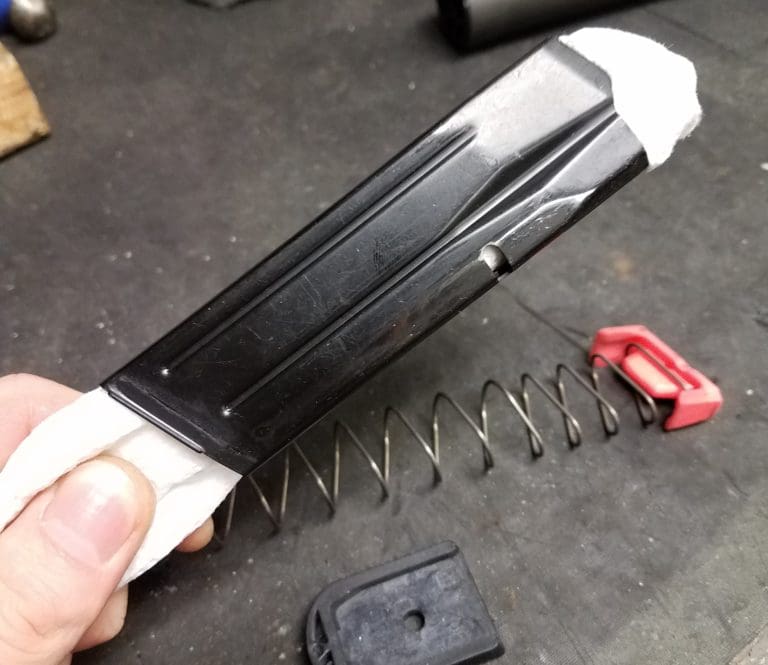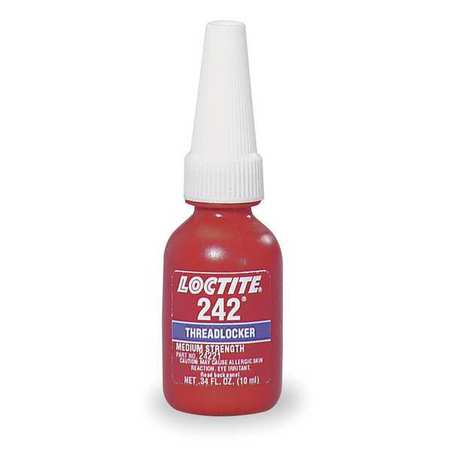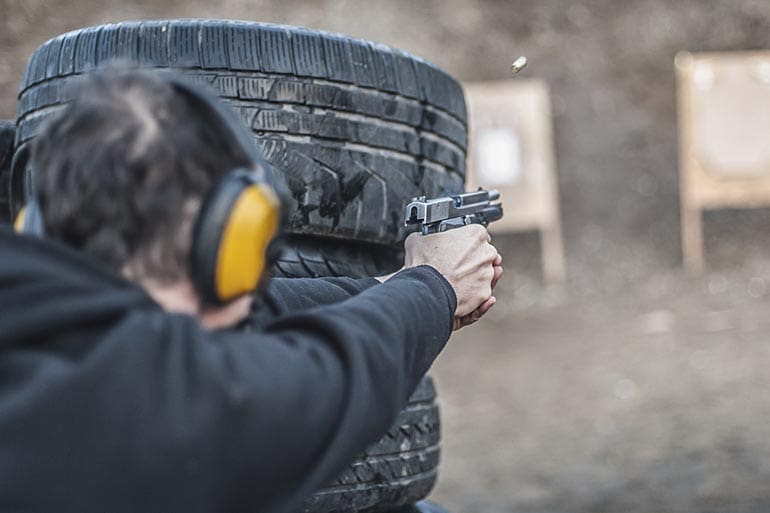There is nothing more frustrating than grinding to halt because your gear has fallen apart, especially in a training class. How many of us have been on the ground trying to find that itty-bitty piece of hardware in a sea of brass?
The Carnage

I’ve seen plenty of gear-related problems over the years. In a recent concealed carry class, we had a holster come apart, literally. We’ve had a variety of issues — lots of bad magazines — but luckily, we caught most of them before they became real problems.
In one incident, I had the front sight come loose on my pistol. I’m actually glad it was the sight and not my shooting. The damn thing was listing and I finally asked myself, is it me, or is my sight post really leaning?
It’s virtually impossible to work with equipment that doesn’t have some type of fastener. No matter how tight you make it, whether or not you used Loctite, or whether the proper torque was applied, periodic maintenance is required. Especially if you shoot often.
The Basic Tools

One of the best tools I’ve ever put in a range bag is a small screwdriver with the various spare bits stored in the body. I love this tool. It has done me right over the years.

No matter how small your range bag, there’s always room for one of those. In addition, a small tube of thread locker will help ensure you don’t have to repeat the process anytime soon. While there are many tools you could keep on hand, these are the minimum, in my opinion.
The Maintenance Interval

When it comes to your holsters and magazine carriers, I suggest checking all the hardware once a month. Some may go so far as to recommend using thread locker on all of your hardware. For some gear, that’s required; for others, not so much.
Learn what causes the hardware to come loose first. If you apply a thread locker to your concealed carry gear, go with the lightest bond. You don’t want permanence; you want security.
At the end of a high-intensity class with lots of draw stroke repetitions, do yourself a favor and check the screws in your gear. If they’re loose, hopefully you’ve avoided a mishap. Losing hardware can land you in a tight spot; lots of folks have spare guns or extra magazines, but how many carry more than one holster? Checking your hardware is a simple solution.
Big Picture Logistics
There’s a saying that goes, “Amateurs argue tactics, and professionals argue logistics.” Often in my classes, students with niche or exotic guns find themselves in a pickle with their gear. Other students will go out of their way in an effort to help, but it’s hard to help you when your gear is so far out on the fringe.
I carry spare equipment and gear to every class and have loaned it out many times. But more than once, I couldn’t help a student with a problem because our gear didn’t match what they’d brought. There’s something to be said for using widely owned guns and gear that can be easily switched out with what others are using.
Preparation can go a long way, as can spare parts and hardware. Put some thought into your periodic and mandatory maintenance routines, as well as what hardware and maintenance gear you bring with you when you train. It will save you time, trouble, and you’ll be glad you did.
Jeff Gonzales is a former US. Navy SEAL and preeminent weapons and tactics instructor. He brings his Naval Special Warfare mindset, operational success and lessons learned unapologetically to the world at large. Currently he is the Director of Training at The Range at Austin. Learn more about his passion and what he does at therangeuastin.com.





How bout a kit that holds all those little machine screws you’re bound to need? Like some screws for your holster and rails. Better to have spares you never need than to hunt that lil screw in a sea of hot spent brass.
Carry a magnet on a telescoping rod
I actually do this when I’m metal detecting, but I have a small wooden dowel with a scientific magnet on the end. ~70Lbs of pull for the whole magnet so only a few pounds on the end. It helps find those irritating pieces of rusty metal from litter bugs before me.
I always bring a backup gun to training courses. Twice (once for handgun, once for shottie), my primary experienced a debilitating mechanical malfunction that knocked it out of commission for the remainder of the course (both were 4-day). Fortunately, I had the backup to carry me thru to the end.
Put that loctite in a sealed container or at least a ziploc.
Anaerobic adhesive is not something you want leaking in your range bag.
I had a tube of red loctite in the change tray on my dashboard once, along with a loose bolt or two.
It leaked and hardened where the bolts and coins touched the dashboard.
Not good.
Double bag it! Had a similar incident, IN my toolbox. Maximum irritation to say the least, and lots of “sailor words”.
I have an old yugo Tokarev that’s so enthusiastic about maintenance that it disassembles itself at the range sometimes. By throwing the entire slide assembly out of the stall and several feet downrange. Thankfully it hasn’t gone far enough that the brass broom couldn’t reach it yet…
That sounds safe… Maybe get that looked into?
Gun is fine.
My russian Tok never did that.
*snickers* Ok Ivan.
Make sure you use the right loctite. Purple is for small screws like most on guns. I put blue on some grip screws and had a heck of a time removing them, should have used the purple.
And never use red Loctite unless you know what you’re doing and what it will mean to remove it.
Red Loctite needs heat to break it loose. If you use a Loctite product that needs heat to break it loose on polished, nitre-blued screws, it’s a good bet that your nitre blueing job is going to be wrecked by heating the screw to get it loose.
I’ve run into a tendency of some of the larger gun companies now using Loctite (or similar product) on the barrel/receiver thread joint. This is silly in the extreme. Over 100 million Mauser-pattern rifles have been produced in the last 120 years, and none of them had barrels falling off without Loctite or a similar product on them.
“never use red Loctite unless you know what you’re doing and what it will mean to remove it”
This can’t be said enough…
I have one AR with a foreend that specified using red to attach it; naturally, that build was also the only one I had to undo and reattach 3 times. I had to get handy with my propane torch to do it.
“But, but, but re-timing a brake is a pain” said a bunches of people. 😀
if you used red loctite on tritium sights, when you heat it enough to get it off it will make it dim.
and that’s if you didn’t already pop the vial or melt plastic.
around 500 F
And remember it will separate in the tube/bottle and you’ll lose a bunch of the solvent (?) if you don’t shake it up. Even when I was a working mechanic I could rarely use the whole bottle without it going bad, so stick with the tube.
Whew. You had me worried. I used some loctite on mounting a small rail to a rifle (for a scope mount). The tube is red in color, but has big letters saying BLUE removable 242 on the tube.
I’ve been accused more than once of having a screw loose…
i’m the loose nut behind the wheel.
I have an upper that I purchased years ago, and the idiots who assembled it used red loctite to screw the top half of the quad rail to the bottom. I was able to use a propane torch to get one of the screws out, the rest not so much. When I get around to it, gonna use a cutting wheel on it eventually.
Especially in a training class? How about especially in competition? Now that is major suck. Fortunately, in that situation, we are all running the same “niche” guns!
This time of year black nail polish should be in stores, works great to keep things tight. Also hides minor AWWCRAP mistakes. Clear polish is good too. You just get funny looks shopping in that isle at the store. Rocksett for muzzle devices or anything that might get hot enough to release Loctite red but you don’t mind soaking in water for about 12 hours to release.
Loctite sells a form that comes in a tube like chapstick, handy if you keep in a range bag.
A small magnetic service dish to hold disassembled parts as found in many automotive parts stores should be in the kit bag along with a properly sized bit driver (straight, Phillips, Torx, Allen) and lubricant. Losing a screw or pin usually ends things on the spot.
speaker magnet. many sizes to choose from. some of them come off the frame too.
I used red loctite to hold the P938 guide rod together. Known issue with the 938, two part guide rod.
“How many of us have been on the ground trying to find that itty-bitty piece of hardware in the sea of brass?”
A magnet is your friend.
Magnet broom is better. Less fiddly, but picks up every, allthethings ferrous.
You change the oil in your car’s engine, you do I assume, so why not make the smaller effort to do a quick check of your firearms and related gear. Changing engine oil at appropriate intervals could save you some money, perhaps a lot of money. Checking firearms related gear could save your life.
In addition to what’s already been mentioned, make sure you have lubricant, be it oil, grease, whatever. A dowel for knocking out a stuck bullet or case. A flashlight, it may be the most useful tool to have on hand, maybe even over a knife.
Yup. I carry a dowel for a stuck bullet, which I’ve never had; but I did have a stuck split casing once. I tapped it right out after alerting the RO to my problem.
Re: Loctite. Use the blue one.
NOT THE RED ONE!
i remember green being a bitch to loosen as well.
The old green was the bearing retaining stuff i.e you spun a race on a spindle and you use that stuff to take up the gaps after you cleaned off the big boogers.
I’d forgotten about the green one. I think I haven’t seen the green stuff in almost forty years now….
I keep a small set of screw drivers of various types in my range bag. And a multi tool.
Never thought of the magnet.
Weapons are tools, they are always maintained. I have never had a failure…..
True words, Gunny.
Shoe Goo. There should be a tube of it in every tool box right next to the duct tape.
Comments are closed.